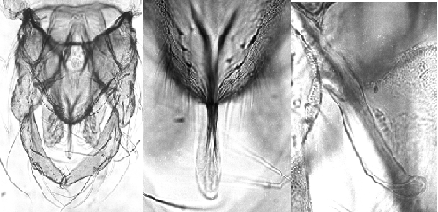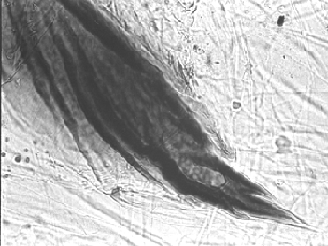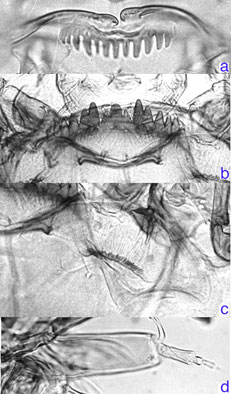Species 2x. C. sp. 2x. Could be C. decumbens Malloch, 1934.
Adults of this species are in the collection of J.E. Sublette at the University of Minnesota.

Male terminalia of C. decumbens(?)
with anal point (centre) and superior volsella (right)
Superior volsella of Strenzke's E-typeClick here to see the description of C. decumbens based on Towne's description. Pupa: Caudo-lateral spur of segment VIII with one large and perhaps two smaller spines. Pupa: Caudo-lateral spur of segment VIII with one large and perhaps two smaller spines.Larva a medium sized salinarius type. Gular region darkened.
Mentum (Fig. b) relatively flat, centre tooth relatively broad with parallel sides, c2 teeth quite well separated (Type IIA); 4th laterals slightly reduced (essentially Type I).
Ventromentum (Fig. c) with about 45 striae; VMR about 0.28. Pecten epipharyngis (Fig. a) with about 13 teeth, an occasional one reduced in size.
Premandible with outer tooth shorter than the inner tooth, which is about 2.7 times wider.
Basal segment of antenna (Fig. d) about 3.6 times as long as broad; AR about 2.6; A1/A2 about 4.3, A4/A3 about 1.14; antennal proportions (µm) 152 : 35 : 9 : 10 : 5.
Development of 3rd inner tooth of mandible not clear.  Cytology: 3 polytene chromosomes with a modified thummi arm combination AB, CD, GEF.
Arm G region unpaired with nucleolus near junction of arm with arm E. Possibly a nucleolus also in the CD chromosome, just proximal to the characteristic constriction of groups 3-4. Found: Alaska - Harding Lake.
The Type locality of C. decumbens Malloch is Nunavut (formerly Northwest Territory) - Southampton Island, Keewatin. The cytology of this species suggests a close relationship to C. islandicus and the species noted as C. nr. decumbens (species h) in that it has a small unpaired arm G and multiple nuclei in the long chromosomes. See also . sp. h and C. islandicus.| Return to Index| Go to References ] | 

